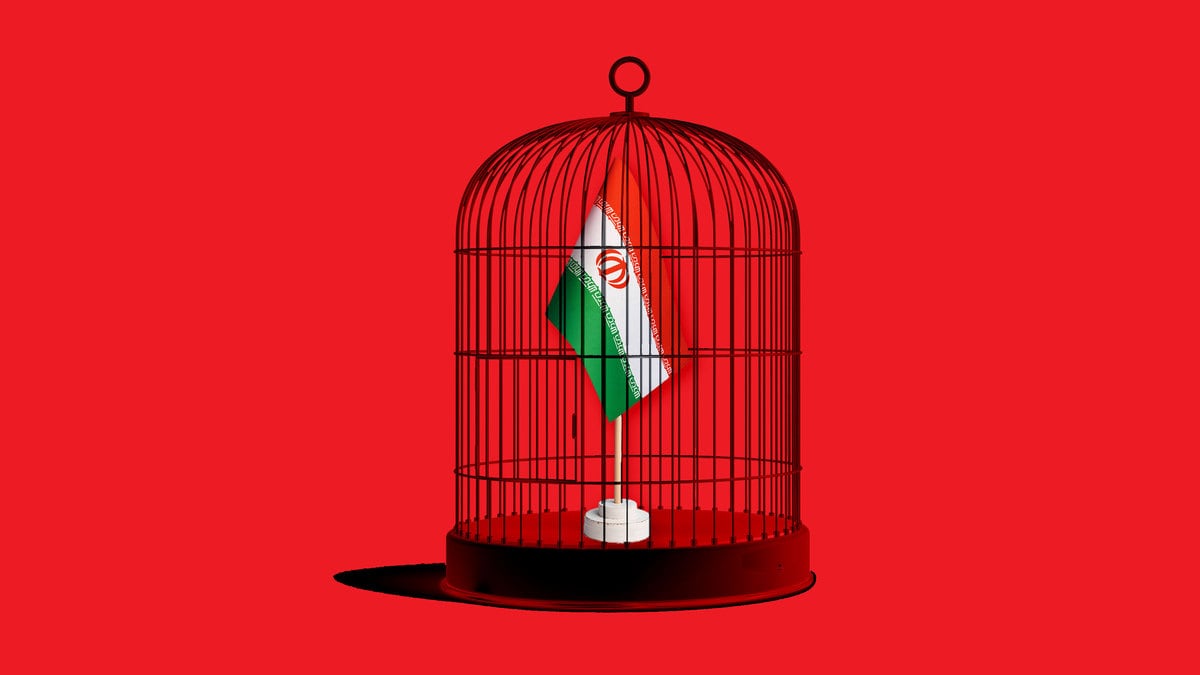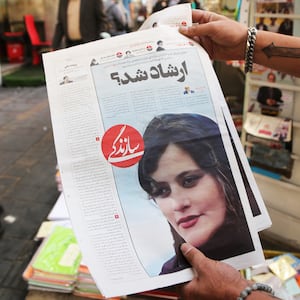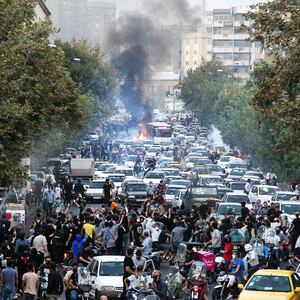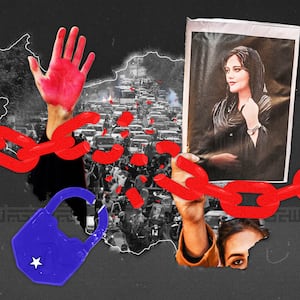“For every one killed, a thousand more of us will rise up.”
That is the latest defiant rallying cry from protesters inside Iran, hundreds of thousands of whom have been engaged in a brave and unprecedented revolutionary movement since the September killing of 22-year-old Mahsa Jina Amini while in the Islamic Republic of Iran’s custody.
That chant is all the more astounding when you consider the context in which it’s being shouted—the public hanging of political prisoners.
ADVERTISEMENT
In three months, the Islamic Republic of Iran regime has indiscriminately arrested more than 18,000 and killed at least 483 people, according to the Human Rights Activists News Agency, an independent non-profit. That death toll includes 68 children, and is likely an underestimate because of the difficulty of verifying information inside the country. The regime has repeatedly restricted internet access in an attempt to quell uprisings, prevent the flow of information, and strangle the ability of the Iranian people to assemble freely. Iran tops this year’s list of countries with the most imprisoned reporters, according to the Committee to Protect Journalists.
Women and girls, who have been at the forefront of this revolution since it began, have been subject to horrific levels of barbarism. Reports from medics inside the country have documented numerous occasions where female protesters have been sexually assaulted, and deliberately shot in the genitals, breasts, and faces. Mothers and grandmothers have taken to social media weeping and begging the regime to spare the lives of their children. Videos from inside Iran show families furiously banging on prison doors around the country, demanding that the regime release their loved ones.
Yet this month, the Islamic Republic of Iran stepped up its already impossible levels of brutality against protesters when it began meting out capital punishment.

A motorcycle on fire in Tehran, on Oct 8, 2022, part of the biggest wave of social unrest in Iran in almost three years.
AFP via Getty ImagesExecutions have been rapid—almost summary—and have followed sham trials where the accused are denied legal representation. These trials are taking place after the accused have allegedly been tortured, some coerced into forced confessions, while others have had their families threatened by the Islamic Revolutionary Guard Corps (IRGC) if they dare to speak out.
On Dec. 8, the regime executed Mohsen Shekari on a charge of “moharebeh”—a Farsi word meaning “waging war against God”—which carries the death penalty.
Shekari’s “crime,” according to the regime, was blocking a street and injuring a Basij guard (the volunteer militia arm of the IRGC). His family and eyewitnesses have countered what they call a false narrative being peddled by the regime, arguing that Shekari saw security forces attacking protesters, and moved a guardrail into the middle of the street to impede the IRGC from being able to continue their assault on everyday Iranians. Shekari was denied the right to choose his own lawyer, and his uncle claimed he had been visibly tortured. Amnesty International has urged the world to take action; at least two dozen other young men are at imminent risk of being killed in a similar fashion.
The Revolutionary Court proceedings that have taken place so far can perhaps best be described as a terrifying blend of kangaroo and kafkaesque. We’ve seen situations in the past month where the prosecutor also literally plays the role of sentencing judge, as happened in the case of Majidreza Rahnavard, 23, the second young man to be arrested and hanged within a three-week timespan. His family reportedly only learned of his death after he was executed in near-secrecy.
As I write, concerns are mounting for Mohammad Boroughani, a 19-year-old protester who was sentenced to death last month, and who has this week reportedly been transferred from prison to an unknown location.
The executions are widely seen by the international community as a barely veiled revenge response from the regime toward protesters who have dared publicly dissent against its draconian theocratic rule, with many on the streets and online calling for the regime’s end. But even with this acknowledgement, there is a level of urgency missing in the international response towards these acts of cruelty by the Islamic Republic. That must change now.
Some may argue that we’ve already seen the international community step up in the 90 days since the protests began—in meaningful but relatively narrow ways.
This week, members of the United Nations Commission on the Status of Women rightly voted overwhelmingly to boot Iran off the women’s rights body, in a motion that passed with 29 nations in support (eight voted against, 16 abstained). The United States led the charge, with Ambassador Linda Thomas-Greenfield, the U.S. Representative to the United Nations, issuing a stern rebuke to the IR in her opening remarks, calling the Islamic Republic of Iran’s membership a “stain on our credibility.”
An overwhelming number of members of the UN Human Rights Council voted in November to create an independent mechanism to investigate the regime’s alleged crimes against its people—including extrajudicial killings, imprisonments, and murders of children. The UN High Commissioner for Human Rights, Volker Türk, called the situation inside Iran painful to watch.
“The old methods and the fortress mentality of those who wield power simply don’t work,” Turk said. “Change is inevitable. The way forward is meaningful reforms.” But part of that change has to include a swift rebuke and shift in approach from nations like Germany and the U.K. in response to the executions.
There is some division on how to proceed.
Hannah Neumann, a German Member of European Parliament and prominent outspoken critic of the current Iranian regime—so much so that she was added to an IR sanctions list this month—has expressed reluctance to heed the call from some to shut down embassies. She recently tweeted: “I don’t think it helps protesters in #Iran, if we turn the country into a second North Korea by closing all our embassies.”
Neumann argues that embassies act as a foreign government’s eyes and ears overseas, and are necessary to provide propaganda-free, verifiable information about what’s happening inside Iran, an important task given the country has expelled nearly all international journalists, and continues to imprison its own journalists.
Gissou Nia, the director of the strategic litigation project at the Atlantic Council and one of the prominent human rights lawyers who helped spearhead this week’s UN vote, agrees in part with Neumann’s concerns against a total severance of all diplomacy. But Nia argues that there are ways to apply pressure without shuttering embassies, including the temporary downgrading of diplomatic ties. That means nations with existing relationships with Iran must immediately recall their ambassadors.

Iranian Supreme Leader Ali Khamenei speaks about the country-wide protests in Tehran, Iran, on Nov. 19, 2022.
Iranian Leader Press Office/Anadolu Agency via Getty Images“It has to be a coordinated approach and it’s a really tall ask,” Nia explained as she made her way to D.C. from New York this week. “It would have to be ideally not only EU and European countries, and also explicitly tied to the end of executions of these protesters. It’s an immediate, urgent action. It needs to happen now.”
Recalling ambassadors would send a strong political signal that the executions must stop. Embassies can still function with a chargé d'affaires, and still have the capacity to monitor trials (though the Iranian regime typically resists and prevents nations from meaningfully doing so).
There is a historical precedent for such political action.
In 1992, Sadegh Sharafkandi, an Iranian Kurdish opposition leader, was assassinated along with three other people on German soil, by henchmen of the Islamic Republic of Iran. The case caused a major diplomatic schism between Germany and Iran. Prosecutors at the time argued that Iran’s supreme leader Ayatollah Ali Khamenei, and then-president Hashemi Rafsanjani ordered and approved the killings. After the 1997 verdict in the so-called Mykonos case trial, Germany expelled four Iranian diplomats and recalled its ambassador from Tehran. The EU suspended “critical dialogue” with Iran in response.
More recently, in September 2021, France recalled its ambassador to the U.S. for the first time in a show of fury over the scrapping of a longstanding billion-dollar Franco-Australian nuclear submarine deal in favor of a technology alliance between Canberra and Washington, D.C. Some observers argued that the move gave French President Emmanuel Macron leverage over his relationship with Biden; since the sub spat, the U.S. has been generally vociferous in its praise of Macron, particularly his handling of Ukraine, and Macron scored the first state visit of Biden’s presidency this month.
France has a unique role in utilizing a similar methodology to indicate its own anger and intolerance for the Iranian regime’s behavior now.
Macron has already characterized the uprisings inside Iran as a “revolution,” and could help coordinate a collective European response to the executions and lead his fellow EU bloc members and non-EU nations in the West to temporarily downgrade diplomatic ties until the Iranian regime commits to stop executing protesters.
Of course, there are other ways that the international community can flex its collective muscle to send a united message to the regime that executions of its own people in this manner is contrary to international law, and will not be tolerated. The EU has already issued a tranche of sanctions against Iran for its role in supplying drones to Russia as part of the ongoing war in Ukraine, as well as its human rights violations. More sanctions are likely to come.
But with the ongoing capital punishment threat in Iran to so many protesters, we need to see more action from the international community beyond economic condemnations which have yet to slow the regime’s deadly reaction to the popular uprisings across Iran.
Nia, for one, feels that there is some momentum to be built on after the UN vote this week. “We’re at a turning point,” she said.









